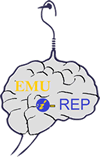The genus Pistacia L. is a member of the family Anacardiaceae and consists of 10
accepted species. According to monograph of Zohary published on 1952, the genus
is divided into 4 sections and 11 species included. In Northern Cyprus 4 Pistacia
species occur, wild ones: P. atlantica Desf. , P. lentiscus L., P. terebinthus L., and
cultivated one P. vera L.. The male trees use for to extract resin and female trees
produce red drupe fruits which is use to make traditional hard biscuits at patisseries.
Pistacia lentiscus is an evergreen shrub or small dioecious tree. Leaves are
paripinnate with strong resin odour. Leaflets 6 or 8 pairs are elliptical, apex and base
acute, margin entire. At spring-summer seasons it gives white flowers. It is multi trunked plant with many branches and generally resists to breakage.
In this study leaf anatomical characteristics and antimicrobial effect of its fruit have
been check with methanol (CH3OH), chloroform (CHCl3), dichloromethane
(CH2Cl2), acetone (CH3COCH3), hexane (C6H14), ethanol (C2H5OH) and distilled
water (H2O) extracts against gram positive and gram negative bacteria such as; E.
coli ,K. pneumoniae S aureus and E. faecalis, was investigated. All examined
specimens collected from wild population in Karpaz region.
The cross section of the leaflets made by hand, it is observed that on both surface q
single layer of thin walled epidermal cells, covered by thick layer cuticula. Leaves
are dorsiventral (bifacial) adaxial palisade consists of one layer, and the abaxial the
abaxial spongy parnchima consists of several layers and the cell wall are very similar
in appearance. Stoma only occurs on upper surface, no hairs.
MIC of all chemicals extracts is investigated to be 128 mg/L.
Keywords: Pistacia lentiscus, anatomical structure of seeds, antibacterial activity.
ÖZ:Pistacia L. cinsi, Anacardiaceae familyasının bir üyesidir ve son literatüre göre 10
kabul edilen türden oluşmaktadir. 1952'de yayınlanan Zohary'nin monografisine
göre, cins olarak 4 seksiyona ayrılmıştır ve 11 türe vardır.. Kuzey Kibris’ta 4
Pistacia türü bulunmaktadır, yabani olanlar P.atlantica Desf., P. lentiscus L., P.
terebinthus L., ve yetiştirilen tek tür P. vera L. Erkek ağaçlardan recine elde
edilmekte ve dişi ağaçlar kırmızı sert meyveleri Kıbrıs'ta pastanelerde geleneksel
olarak peksemet (sert bisküvi) yapımında kullanılmaktadır. Pistacia lentiscus, yaprak
dökmeyen bir çalı veya küçük bir ağaçtır. Yapraklar paripennattır ve güçlü reçine
kokusuna sahiptir. Yaprakçıklar 6 veya 8 eliptik, akut, kenarları tam olayaprakçıktan
oluşur. İlkbahar-yaz mevsiminde beyaz çiçekler açmaktadır. Çok gövdeli ve çok dallı
bir bitkidir, genellikle kırılmaya karşı dayanıklıdır. Pistacia türlerinde az sayıda
anatomik çalışma yayınlanmıştır. Bu çalışmada, Karpaz yöresinden doğal
ortamından toplanan örneklerin yapraklarının anatomik özellikleri ve meyvelerinin
antibakteriyel aktivitesi metanol, kloroform, diklorometan, aseton, heksan, ethanol ve
su ekstrelerinin gram positive ve gram negative microrganismalarinin ki bunlar; S.
aureus, E. faecalis, E. coli ve K. pneumoniae üzerindeki etkisi incelendi. Bitkinin
yaprak kesitleri el ile alınmıştır, microskope incelemesi sonucunda yaprağın her iki
yüzeyinde de ince tek tabaka halinde epiderma hücreleri, kutiküla kalın, yapraklar
dorsiventral tiptedir, üstte palizat parenkiması, alt yüzde ise sünger parenkiması yer
alır. Palizat parenkiması tek sıra hücreden oluşmaktadır. Sünger parenkiması ise
birbirine benzeyen çok sıralı hücreden meydana gelmiştir. Stomalar sadece üst
yüzeyde bulunur ve yapraklarda tüy gözlenmemiştir.
Meyvenin minimum inhibitör konsantrasyonunun 128 mg/L'den olduğu metanol,
kloroform,diklorometan, aseton, heksan, ethanol ve su ekstrelerini kullanarak yapilan
deneylerde belirlenmiştir.
Anahtar Kelimeler: Pistacia lentiscus, meyvesinin anatomikal yapısı, antibakteriyal
aktivitesi.









